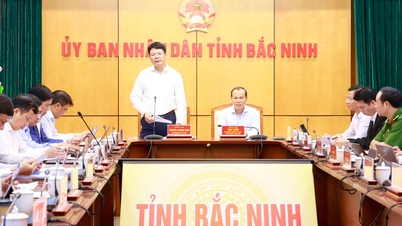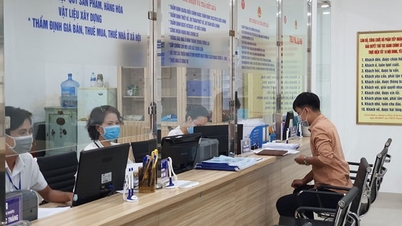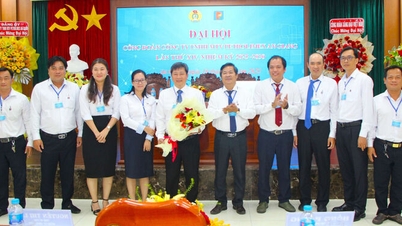Building a modern tax management system
Currently, the tax authority is managing more than 1 million businesses, more than 300,000 organizations, more than 2 million individuals, business households and more than 80 million personal tax codes. The system of tax administrative procedures is continuously reviewed, reduced and simplified, from 435 procedures to 304 procedures in 2021; by 2025 it will be reduced to 219 procedures, of which about 44% will continue to be recommended to be reduced and streamlined. Along with that, the requirement to innovate tax management methods is posed in the context of the booming digital economy , cross-border e-commerce and the emergence of new business models.
According to the Director of the Tax Department Mai Xuan Thanh: In recent times, the tax sector has strongly implemented digital transformation, built a modern information technology system, applied artificial intelligence (AI) and big data in management. A series of advanced electronic tax services have been put into operation such as electronic invoices, electronic invoices generated from cash registers, eTax Mobile application, information portal for foreign suppliers, information portal for households and individuals doing e-commerce, AI application to support taxpayers, automatic personal income tax refund application... To date, more than 99% of businesses have used electronic tax declaration and payment services; 100% of businesses use electronic invoices; nearly 7 million people use eTax Mobile software.

Delegates experience the latest tax management technologies at the tax industry's digital transformation fair, September 2025. Photo: VAN HUNG
The tax sector is assessed by experts as one of the leading units in connecting national data and effectively exploiting data sources according to Project 06 on developing population data applications, electronic identification and authentication to serve national digital transformation. Connecting electronic identification has helped tax authorities "clean" taxpayer data, while serving unified management of individuals, organizations and businesses. To date, more than 30 million taxpayers have accessed the system using electronic identification accounts. In 2025, the tax sector will continue to connect with the national data center to optimally exploit shared data to serve administrative procedures, especially in the fields of land, vehicle registration, statistics, finance and budget management.
An important breakthrough is that from January 1, 2026, the entire industry will completely eliminate the lump-sum tax form for business households, synchronously switching to a self-declaration and self-payment mechanism. This is to create an equal and transparent business environment, encourage production and business development and make sustainable contributions to the state budget. To better serve people and businesses, the tax industry has just announced a tax information portal to support entrepreneurs, and at the same time released a set of 3 "Electronic Tax Handbooks" for business owners, chief accountants, business households and individuals. The handbooks are integrated with AI to support smart questions and answers, helping to look up and apply tax policies and administrative procedures quickly and conveniently.
Perfecting policies and mechanisms for innovation
According to Deputy Director of the Tax Department Mai Son, although the tax sector has made many strides, there are still issues that need to be further improved. Redesigning a modern tax management model, linked to data infrastructure and digital technology , is an important step to improve management efficiency and ensure synchronization with the national database. The ultimate goal is to serve management well, while creating a transparent and fair business environment, fostering sustainable revenue sources, and contributing to the implementation of the country's major goals on social security, infrastructure development, and strengthening national defense and security.

MISA Joint Stock Company staff advises business households on tax declaration and payment software installed on smartphones. Photo: HA TRANG
Associate Professor, Dr. Phung Thanh Quang (Institute of Banking and Finance, National Economics University) said that the tax industry needs to strongly develop digital services for taxpayers through smart information portals, chatbots (AI-based virtual assistants) to support convenient tax declaration and payment via e-wallets or mobile banking applications. Along with that, it is necessary to strengthen revenue management and prevent tax losses in e-commerce activities, especially with cross-border platforms such as Google, Facebook, Shopee, TikTok...
In order for tax policies to play a role in supporting startups and small and medium-sized enterprises, Dr. To Hoai Nam, Permanent Vice President and General Secretary of the Vietnam Association of Small and Medium Enterprises, proposed: “Tax policies must be clear, unified, and easy to understand; increase the application of information technology, minimize procedures, and move towards post-audit. For startups, there should be appropriate incentive policies such as exemption or reduction of income tax or value-added tax in the early stages, especially for innovative enterprises.” Dr. To Hoai Nam gave an example: Enterprises with revenue of less than VND1 billion/year can be exempted from value-added tax to focus on development. When revenue reaches a larger scale (about VND10 billion/year), the normal tax rate will be applied again. According to him, such breakthrough policies will encourage businesses to boldly invest, develop long-term, and make positive contributions to the national economy.
Source: https://baolaocai.vn/phat-trien-cac-dich-vu-so-cho-nguoi-nop-thue-post886478.html




































































































![Dong Nai OCOP transition: [Article 3] Linking tourism with OCOP product consumption](https://vphoto.vietnam.vn/thumb/402x226/vietnam/resource/IMAGE/2025/11/10/1762739199309_1324-2740-7_n-162543_981.jpeg)













Comment (0)